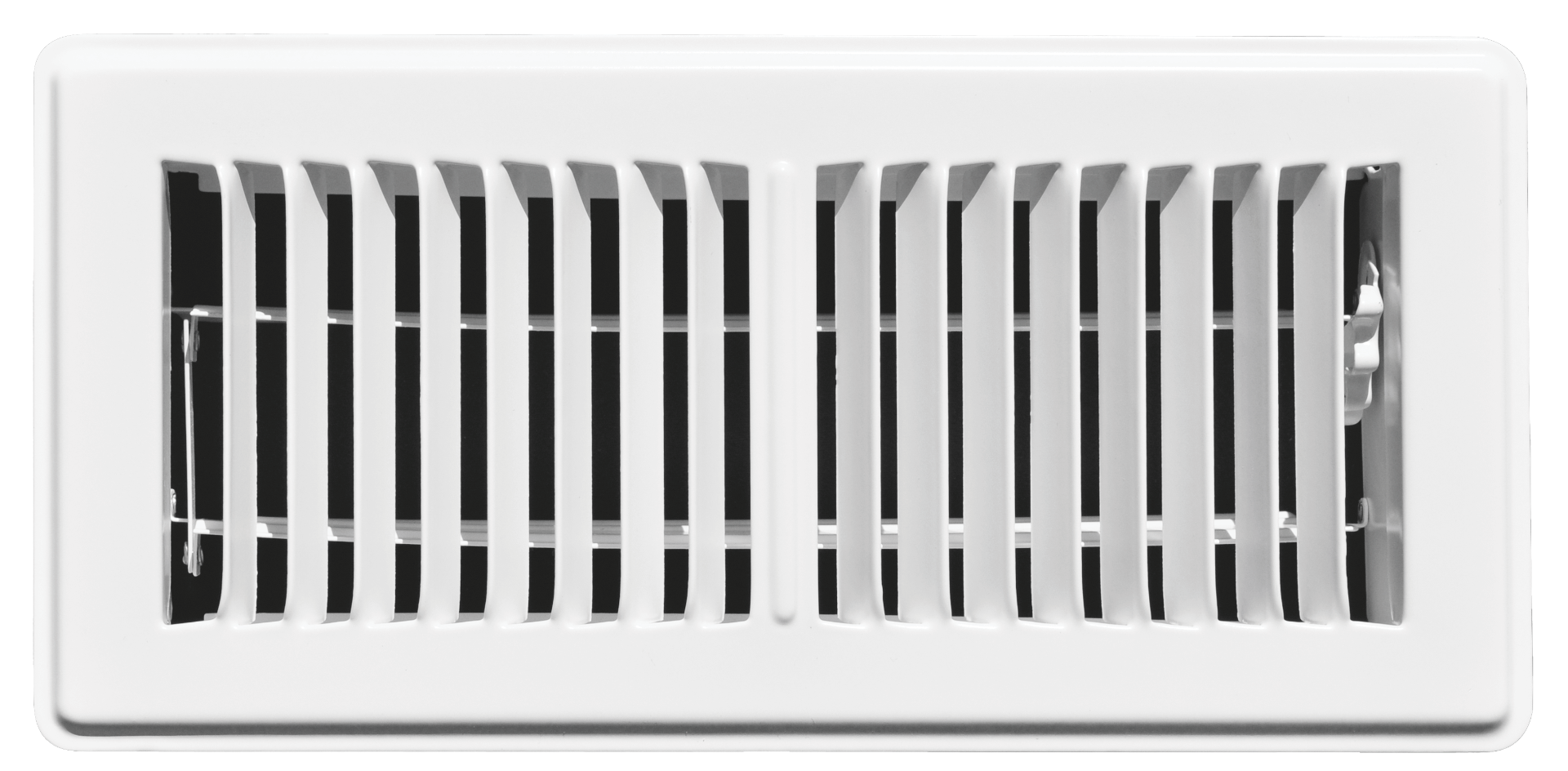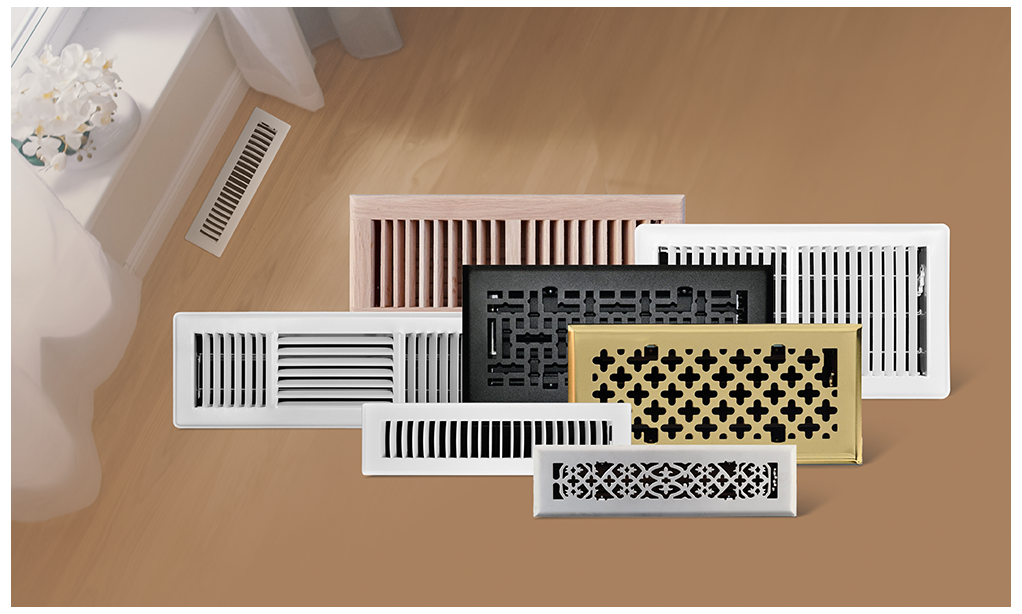In heating, ventilation, and air conditioning (HVAC) systems, floor registers ensure efficient air distribution throughout your home or business. Despite their often-overlooked role, these components are vital to maintaining a comfortable indoor environment.
What is a Floor Register?
A floor register is a combination grille and damper assembly over an air opening to regulate airflow from the HVAC system into a room. It serves two primary functions: allowing warm or cool air to enter a room and controlling the direction and amount of airflow. A register’s balancing damper enables you to open or close the vent and direct the air as needed.
Floor registers appear in residential and commercial settings with the HVAC ducts beneath the floor. They are available in several styles, materials, and finishes to complement the decor of any room.

What is the Difference Between a Register and a Vent?
People often use the terms "register" and "vent" are often used interchangeably, but they do not mean the same thing. A vent “a connection in any system or enclosure that may be open to atmosphere or to a lower pressure, space, or vessel and is intended for the transfer of any fluid,” according to the American Society of Heating, Refrigerating, and Air-Conditioning Engineers (ASHRAE). Vent is also a generic term that refers to any opening in the HVAC system found on walls, floors, and ceilings that allows air to enter or exit a room.
On the other hand, a register refers to a vent cover with a damper that can control the airflow. All registers are vents, but not all vents are registers. For example, a return air grille is a type of vent that allows air to be pulled back into the HVAC cooling system, but it typically doesn't have a damper and is not referred to as a register.
What is the Standard Size for a Floor Register?
The size of a floor register refers to the dimensions of the duct opening it covers, not the outer dimensions of the register itself. Standard floor register sizes typically include 4x10 inches, 4x12 inches, and 6x10 inches, though other sizes are available depending on the HVAC system design.
The most common size in residential settings is 4x10 inches. However, commercial buildings might require larger or custom-sized registers depending on the space size and the HVAC system specifications.
How Do You Measure Floor Register Sizes?
Measuring a floor register size is straightforward but requires accuracy to ensure a proper fit. Here is how to measure:
- Remove the old register: If replacing an existing register, remove it from the floor to expose the duct opening.
- Measure the duct opening: Use a tape measure to determine the height by width of the duct opening in inches. You'll use this measurement to select a new register.
- Consider the outer dimensions: While the duct opening size is critical, the register's outer dimensions will be slightly larger to cover the opening and provide a flush fit with the floor.
If you're installing a register for the first time, measure the duct opening after the HVAC ducts are installed but before the flooring is finished, ensuring that the register will fit properly without gaps or overhangs.
What Should You Do If You Have Odd Register Sizes?
If your home or business has non-standard register sizes, don't worry—there are several options available:
- Custom registers: Some manufacturers offer custom-sized registers to fit unique duct openings. This option can be more expensive, but it ensures a perfect fit.
- Trim or expand the opening: Sometimes, it may be possible to trim the duct opening or expand it slightly to fit a standard-sized register. This should only be done if it keeps the integrity of the HVAC system intact.
- Use an adapter: Adapters can modify the duct opening size to accommodate a standard register size, providing a practical solution when custom registers are not an option.
Types of Floor Registers and Materials
Different types of floor registers and materials offer unique benefits, so it's important to choose the right option for your specific needs.
TRUaire and Shoemaker, offered by RectorSeal, provide top-tier floor register solutions known for their high durability, sleek design, and reliable airflow control. Both brands are trusted for their quality craftsmanship and wide variety of styles, ensuring a seamless fit for both residential and commercial HVAC needs. With easy installation and lasting performance, TRUaire and Shoemaker registers are excellent choices for any project.
Types of Floor Registers
Basic Adjustable Registers
These are the most common type of floor register and feature adjustable dampers that allow you to control airflow. They are simple and functional, making them popular for residential homes. Adjusting the damper lets you direct air to certain room areas or close off airflow.
- Best for: Homes or businesses where airflow needs to be managed room-by-room.
- Solutions from TRUaire: 150 Series and 153 Series
Decorative Registers
Decorative floor registers are designed to enhance a room's aesthetic appeal while serving their functional purpose. They come in various intricate patterns, finishes, and styles that can complement any decor, from traditional to modern.
- Best for: Homeowners looking to blend functionality with design, adding a decorative element to their floors.
- Solutions from TRUaire: 160 Series
Heavy-Duty Registers
These registers withstand high foot traffic and heavy usage, making them ideal for commercial spaces or rooms where durability is a concern. Heavy-duty registers are typically made from more robust materials and may feature thicker grilles and stronger frames.
- Best for: Commercial buildings, workshops, or high-traffic areas where standard registers may wear out quickly.
- Solutions from TRUaire: 154 Series and 154R Series
- Solutions from Shoemaker: SM 1600, 1630, and AFP Series
Flush-Mount Registers
The surface of the register is level with the surrounding floor. These registers are often used with hardwood or tile floors to create a seamless, clean appearance.
- Best for: Rooms with hardwood or tile flooring where a smooth, discreet look is desired.
- Solutions from TRUaire: 168FM Series
Toe-Kick Registers
These registers fit into tight or inconspicuous spaces, such as under cabinets or baseboards. They are in kitchens, bathrooms, or areas with limited wall or floor space.
- Best for: Kitchens, bathrooms, or other rooms with limited space for standard registers.
Materials Used in Floor Registers
The material of your floor register can impact its durability, functionality, and appearance. Here are some common materials used in floor registers and the benefits of each:
Steel
Due to its strength and durability, steel is one of the most common materials for floor registers. Steel registers are often powder-coated or painted to resist rust and corrosion. They are available in various finishes, such as white, black, or bronze, to complement different decor styles.
- Benefits: Exceptionally durable, resistant to damage, and long-lasting. Suitable for high-traffic areas.
Aluminum
Aluminum registers are lightweight and rust-resistant, making them an excellent choice for moist areas. Due to their affordability and sleek appearance, they are commonly used in residential and commercial applications.
- Benefits: Lightweight and rust-resistant. Ideal for kitchens, bathrooms, and other damp environments.
Wood
Wood floor registers are a popular choice for rooms with hardwood flooring, as they blend seamlessly into the floor. They are often available in many wood types, such as oak, cherry, or maple, allowing homeowners to match their register in the wood used in the flooring. While they may not be as durable as metal registers, they offer a warm, natural aesthetic that is hard to beat.
- Benefits: Offers a seamless, attractive appearance with hardwood floors. Available in a range of wood types and finishes.
Plastic (ABS Polymer)
Plastic registers, often made from high-grade ABS polymer, are a budget-friendly option resistant to moisture, rust, and mildew. While they may not be as durable as metal registers, they are ideal for bathrooms, basements, and other damp environments.
- Benefits: Affordable, moisture-resistant, and easy to clean. Ideal for areas with high humidity and moisture exposure.
Brass
Brass floor registers are known for their luxurious, high-end appearance. They are in homes with classic or traditional decor styles. Brass registers are durable and resistant to rust but may require regular maintenance to keep their shine.
- Benefits: Adds an elegant, upscale appearance. It is durable and rust-resistant, though it may require polishing to maintain a polished look.
Cast Iron
Cast iron registers are heavy and incredibly durable, often used in historic homes or buildings where traditional materials are preferred. They offer a vintage or industrial aesthetic, but due to their weight, they are best suited for floors that can handle the additional load.
- Benefits: Extremely durable and long-lasting. Offers a vintage, classic appeal for older homes or buildings.
Superior Floor Register Options from RectorSeal
When selecting floor registers, RectorSeal offers durable registers in assorted sizes and finishes. Focusing on quality and ease of installation, RectorSeal's products are popular for residential and commercial applications.
TRUaire is renowned for its wide range of grilles, registers, and diffusers. TRUaire products are offered in standard and custom sizes and multiple finish options, such as white, brown, and aluminum. Their registers are designed for optimal airflow and durability.
Shoemaker offers a comprehensive line of floor registers, including models with adjustable dampers and heavy-duty construction. Their products are available in diverse sizes, materials, and finishes, catering to different aesthetic and functional requirements.
Bottom Line
Floor registers might seem like a small detail, but they play a crucial role in the functionality of your HVAC system. Understanding the difference between a register and a vent, knowing how to measure for the correct size, and knowing what to do with odd sizes will help ensure your system operates efficiently and improve indoor air quality.

